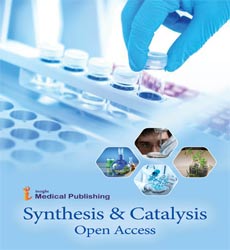ISSN : 2574-0431
Synthesis and Catalysis: Open Access
Molecular Innovations Driving Sustainable Chemical Synthesis and Green Manufacturing Pathways
Kanste Adams
Department of Catalysis and Surface Chemistry, Polish Academy of Sciences, Kraków, Poland
*Corresponding author:
Kanste Adams
Department of Catalysis and Surface Chemistry, Polish Academy of Sciences, Kraków, Poland
Email: kansteadams@sea.pl
Received: February 01, 2025, Manuscript No. ipscoa-25-20548; Editor assigned: February 03, 2025, PreQC No. ipscoa-25-20548; Reviewed: February 15, 2025, QC No. ipscoa-25-20548; Revised: February 20, 2025, QI No. ipscoa-25-20548; Published: February 28, 2025, DOI: 10.21767/2574-0431.2025.11.1.01
Citation: Adams K (2025) Molecular Innovations Driving Sustainable Chemical Synthesis and Green Manufacturing Pathways. Synth Catal Vol: 11 No: 1: 01.
Introduction
The chemical industry is the backbone of modern society, supplying materials, fuels, pharmaceuticals, and countless products that underpin human life and economic development. However, conventional chemical synthesis and manufacturing processes are often resource-intensive, heavily reliant on fossil fuels, and associated with significant environmental burdens such as greenhouse gas emissions, hazardous waste, and water pollution. In an era where sustainability has become a pressing global imperative, there is growing recognition of the need to transition from traditional chemical production toward greener, more resource-efficient, and environmentally responsible pathways. At the heart of this transformation lies the rise of molecular innovationsâ??novel catalytic systems, biocatalytic tools, engineered metabolic pathways, and advanced material sciencesâ??that are enabling sustainable chemical synthesis and green manufacturing [1].
Description
The foundation of sustainable chemical synthesis rests upon the development of advanced catalytic systems capable of performing efficient, selective, and energy-saving transformations. Traditional chemical reactions often require high temperatures, toxic solvents, and expensive reagents, leading to inefficiencies and waste generation. Metal-organic frameworks (MOFs), nanoparticle catalysts, and enzyme-inspired catalysts provide unprecedented levels of control over reaction selectivity and efficiency. For instance, molecularly engineered catalysts allow for the conversion of carbon dioxide into fuels and value-added chemicals under mild conditions, addressing both energy sustainability and carbon mitigation. Similarly, the use of photocatalysts and electrocatalysts harnesses renewable energy sources such as sunlight or electricity to drive reactions that traditionally relied on fossil-based energy [2].
Equally transformative is the development of green solvents and reaction media, which play a critical role in reducing the ecological footprint of chemical manufacturing. Conventional solvents such as chlorinated hydrocarbons pose significant health and environmental hazards. Molecular innovations have introduced alternatives such as ionic liquids, deep eutectic solvents, and supercritical fluids that combine efficiency with eco-friendliness. Ionic liquids, for instance, can be tailored at the molecular level to provide specific solvent properties, enabling efficient separations and catalysis without volatility or toxicity. Supercritical carbon dioxide offers a non-toxic, recyclable medium for diverse reactions, while water, as the ultimate green solvent, is increasingly being utilized through the design of water-tolerant catalysts [3].
Molecular innovations are also driving advances in feedstock diversification, which is central to achieving sustainability in chemical synthesis. The reliance on fossil fuels as primary feedstocks has contributed to climate change and resource depletion. By contrast, renewable feedstocks such as lignocellulosic biomass, agricultural residues, and algae represent abundant and carbon-neutral alternatives. Converting these complex biological materials into platform chemicals requires a suite of molecularly engineered enzymes, catalysts, and microbial pathways capable of breaking down cellulose, hemicellulose, and lignin efficiently [4].
Beyond individual processes, molecular innovations are fostering systemic changes in green manufacturing pathways. Process intensification, enabled by continuous flow chemistry and microreactor technologies, has been revolutionized through molecular-level design of catalysts and reaction conditions. These approaches allow for safer, more efficient, and scalable production systems that minimize waste and energy consumption. For instance, continuous-flow biocatalysis, powered by immobilized enzymes or engineered microbes, enables real-time production of pharmaceuticals with minimal resource input. Similarly, process intensification strategies coupled with molecular innovations in catalysis allow industries to achieve higher yields with smaller footprints [5].
Conclusion
Molecular innovations stand at the forefront of the global transition toward sustainable chemical synthesis and green manufacturing pathways. By harnessing advances in catalysis, biocatalysis, renewable feedstocks, green solvents, nanotechnology, and synthetic biology, researchers and industries are reimagining how chemicals and materials are produced, used, and recycled. These innovations offer solutions to some of the most pressing challenges of our time, from reducing greenhouse gas emissions and curbing plastic waste to ensuring energy security and preserving ecological health. Importantly, molecular-level design does not merely improve existing processesâ??it transforms them, creating entirely new pathways that align with the principles of efficiency, circularity, and environmental stewardship. Yet the realization of this sustainable vision requires concerted efforts to overcome technical, economic, and societal barriers. With continued investment in research, cross-disciplinary collaboration, and responsible innovation, molecular advances can unlock a new era of green chemistry and sustainable manufacturing.
Acknowledgement
None.
Conflict of Interest
None.
References/
- Gawande MB, Shelke SN, Zboril R, Varma RS (2014). Microwave-assisted chemistry: Synthetic applications for rapid assembly of nanomaterials and organics. Acc Chem Res 47: 1338-1348.
- Polshettiwar V, Varma RS (2008). Aqueous microwave chemistry: A clean and green synthetic tool for rapid drug discovery. Chem Soc Rev 37: 1546-1557.
Google Scholar Cross Ref Indexed at
- Polshettiwar V, Varma RS (2008). Microwave-assisted organic synthesis and transformations using benign reaction media. Acc Chem Res 41: 629-639.
Google Scholar Cross Ref Indexed at
- Namboodiri VV, Varma RS (2002). Solvent-free sonochemical preparation of ionic liquids. Org Lett 4: 3161-3163.
- Baruwati B, Varma RS (2009). High value products from waste: Grape pomace extract-a threeâ?Âinâ?Âone package for the synthesis of metal nanoparticles. Chem Sus Chem 2: 1041-1044.
Open Access Journals
- Aquaculture & Veterinary Science
- Chemistry & Chemical Sciences
- Clinical Sciences
- Engineering
- General Science
- Genetics & Molecular Biology
- Health Care & Nursing
- Immunology & Microbiology
- Materials Science
- Mathematics & Physics
- Medical Sciences
- Neurology & Psychiatry
- Oncology & Cancer Science
- Pharmaceutical Sciences
